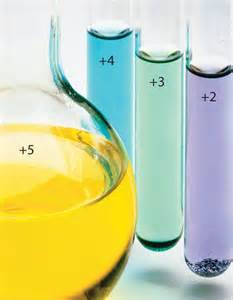Atomic vanadium, #Z=23#, has an electronic configuration of #[Ar] 3d^3 4s^2#. The colours of transition metal ions are, to a first approximation, related to electronic transitions of the #d-"electrons"#.......
Given that #V^(V+)# has NEITHER #"d-electrons"# nor #"s-electrons"#, there are no valence electrons to give rise to a absorption in the visible region.
On the other hand, #V^(+III)#, (and #V^(+II)#, and #V^(+III)#, #V^(+IV)#) are conceived to have #3d# electrons, and their electronic transitions gives rise to colour......

The illustration displays solution of #V(IV+)#, #V(IV+)#, #V(III+)#, and #V(II+)#..............
In fact vanadium has a very large redox manifold, and with many accessible oxidation states displays a rainbow of colours.........

